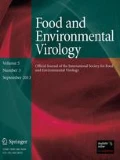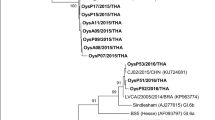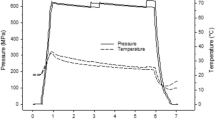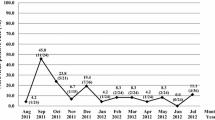Abstract
Contamination of bivalve shellfish, particularly oysters, with norovirus is recognised as a significant food safety risk. Methods for quantification of norovirus in oysters using the quantitative real-time reverse transcription polymerase chain reaction (RT-qPCR) are well established, and various studies using RT-qPCR have detected norovirus in a considerable proportion of oyster samples, both in the UK and elsewhere. However, RT-qPCR detects viral genome, and by its nature is unable to discriminate between positive results caused by infectious viruses and those caused by non-infectious remnants including damaged virus particles and naked RNA. As a result, a number of alternative or complementary approaches to RT-qPCR testing have been proposed, including the use of infectious viral indicator organisms, most frequently F-specific RNA bacteriophage (F-RNA phage). In this study, we investigated the relationships between F-RNA phage and norovirus in digestive tissues from two sets of oyster samples, one randomly collected at retail (630 samples), and one linked to suspected norovirus illness outbreaks (nine samples). A positive association and correlation between PCR-detectable levels of genogroup II F-RNA bacteriophage (associated with human faecal contamination) and norovirus was found in both sets of samples, with more samples positive for genogroup II phage, at generally higher levels than norovirus. Levels of both viruses were higher in outbreak-related than retail samples. Infectious F-RNA phage was detected in 47.8% of all retail samples, and for a subset of 224 samples where characterisation of phage was carried out, infectious GII phage was detected in 30.4%. Infectious GII phage was detected in all outbreak-related samples. Determination of infectivity ratios by comparing levels of PCR-detectable (copies/g) and infectious GII phage (pfu/g) revealed that in the majority of cases less than 10% of virus detected by RT-qPCR was infectious. Application of these ratios to estimate infectious norovirus levels indicated that while 77.8% of outbreak-related samples contained > 5 estimated infectious norovirus/g, only 13.7% of retail samples did. Use of a combination of levels of PCR-detectable norovirus and infectious F-RNA phage showed that while only 7.0% of retail samples contained both > 100 copies/g norovirus and > 10 pfu/g F-RNA phage, these combined levels were present in 77.8% of outbreak-related samples, and 75.9% of retail samples with > 5 estimated infectious norovirus/g. We therefore suggest that combining RT-qPCR testing with a test for infectious F-RNA phage has the potential to better estimate health risks, and to better predict the presence of infectious norovirus than RT-qPCR testing alone.




Similar content being viewed by others
References
Anonymous (2004). Regulation (EC) No 854/2004 of the European Parliament and of the Council of 29 April 2004 laying down specific rules for the organisation of official controls on products of animal origin intended for human consumption. Official Journal of European Communities, L226, 83–127.
Anonymous (2013). Microbiology of food and animal feed -- Horizontal method for determination of hepatitis A virus and norovirus in food using real-time RT-PCR -- Part 1: Method for quantification. In ISO/TS 15216-1:2013. Geneva: International Organization for Standardization.
Anonymous, 2015. National Shellfish Sanitation Program. Guide for the Control of Molluscan Shellfish, 2015 Revision. https://www.fda.gov/food/guidanceregulation/federalstatefoodprograms/ucm2006754.htm.
Anonymous (2017). Microbiology of the food chain -- Horizontal method for determination of hepatitis A virus and norovirus using real-time RT-PCR -- Part 1: Method for quantification. In ISO 15216-1:2017. Geneva: International Organization for Standardization.
Beekwilder, J., Nieuwenhuizen, R., Havelaar, A. H., & van Duin, J. (1996). An oligonucleotide hybridization assay for the identification and enumeration of F-specific RNA phages in surface water. Journal of Applied Bacteriology, 80, 179–186.
Bellou, M., Kokkinos, P., & Vantarakis, A. (2013). Shellfish-borne viral outbreaks: A systematic review. Food and Environmental Virology, 5, 13–23.
Bosch, A., Pintó, R. M., & Abad, F. X. (2006). Survival and transport of enteric viruses in the environment. In S. M. Goyal (Ed.), Viruses in foods. food microbiology and food safety (pp. 151–187). Boston: Springer.
Cole, D., Long, S. C., & Sobsey, M. D. (2003). Evaluation of F + RNA and DNA coliphages as source-specific indicators of fecal contamination in surface waters. Applied and Environmental Microbiology, 69, 6507–6514.
Costafreda, M. I., Bosch, A., & Pintó, R. M. (2006). Development, evaluation, and standardization of a real-time TaqMan reverse transcription-PCR assay for quantification of hepatitis A virus in clinical and shellfish samples. Applied and Environmental Microbiology, 72, 3846–3855.
da Silva, A. K., Le Saux, J. C., Parnaudeau, S., Pommepuy, M., Elimelech, M., & Le Guyader, F. S. (2007). Evaluation of removal of noroviruses during wastewater treatment, using real-time reverse transcription-PCR: different behaviors of genogroups I and II. Applied and Environmental Microbiology, 73, 7891–7897.
Dancer, D., Rangdale, R. E., Lowther, J. A., & Lees, D. N. (2010). Human norovirus RNA persists in seawater under simulated winter conditions but does not bioaccumulate efficiently in Pacific oysters (Crassostrea gigas). Journal of Food Protection, 73, 2123–2127.
Dancho, B. A., Chen, H., & Kingsley, D. H. (2012). Discrimination between infectious and non-infectious human norovirus using porcine gastric mucin. International Journal of Food Microbiology, 155, 222–226.
Doré, W. J., Henshilwood, K., & Lees, D. N. (2000). Evaluation of F-specific RNA bacteriophage as a candidate human enteric virus indicator for bivalve molluscan shellfish. Applied and Environment Microbiology, 66, 1280–1285.
Doré, W. J., Mackie, M., & Lees, D. N. (2003). Levels of male-specific RNA bacteriophage and Escherichia coli in molluscan bivalve shellfish from commercial harvesting areas. Letters Applied Microbiology, 36, 92–96.
Ettayebi, K., Crawford, S. E., Murakami, K., Broughman, J. R., Karandikar, U., Tenge, V. R., Neill, F. H., Blutt, S. E., Zeng, X. L., Qu, L., Kou, B., Opekun, A. R., Burrin, D., Graham, D. Y., Ramani, S., Atmar, R. L., & Estes, M. K. (2016). Replication of human noroviruses in stem cell-derived human enteroids. Science, 353, 1387–1393.
European Food Safety Authority Panel on Biological Hazards. (2012). Scientific Opinion on Norovirus (NoV) in oysters: methods, limits and control options. EFSA Journal, 10, 2500.
Flannery, J., Keaveney, S., & Doré, W. (2009). Use of FRNA bacteriophages to indicate the risk of norovirus contamination in Irish oysters. Journal of Food Protection, 72, 2358–2362.
Hartard, C., Banas, S., Loutreul, J., Rincé, A., Benoit, F., Boudaud, N., & Gantzer, C. (2016). Relevance of F-specific RNA bacteriophages in assessing human norovirus risk in shellfish and environmental waters. Applied and Environmental Microbiology, 82, 5709–5719.
Hassard, F., Sharp, J. H., Taft, H., LeVay, L., Harris, J. P., McDonald, J. E., Tuson, K., Wilson, J., Jones, D. L., & Malham, S. K. (2017). Critical Review on the Public Health Impact of Norovirus Contamination in Shellfish and the Environment: A UK Perspective. Food and Environmental Virology, 9, 123–141.
Havelaar, A. H., & Hogeboom, W. M. (1984). A method for the enumeration of male-specific bacteriophages in sewage. Journal of Applied Bacteriology, 56, 439–447.
Havelaar, A. H., Hogeboom, W. M., & Pot, R. (1985). F specific RNA bacteriophages in sewage: Methodology and occurrence. Water Science and Technology, 17, 645–655.
Hewitt, J., Leonard, M., Greening, G. E., & Lewis, G. D. (2011). Influence of wastewater treatment process and the population size on human virus profiles in wastewater. Water Research, 45, 6267–6276.
Hoehne, M., & Schreier, E. (2006). Detection of Norovirus genogroup I and II by multiplex real-time RT- PCR using a 3′-minor groove binder-DNA probe. BMC Infectious Diseases, 6, 69.
Jones, M. K., Watanabe, M., Zhu, S., Graves, C. L., Keyes, L. R., Grau, K. R., Gonzalez-Hernandez, M. B., Iovine, N. M., Wobus, C. E., Vinjé, J., Tibbetts, S. A., Wallet, S. M., & Karst, S. M. (2014). Enteric bacteria promote human and mouse norovirus infection of B cells. Science, 346, 755–759.
Kageyama, T., Kojima, S., Shinohara, M., Uchida, K., Fukushi, S., Hoshino, F., Takeda, N., & Katayama, K. (2003). Broadly reactive and highly sensitive assay for Norwalk-like viruses based on real-time quantitative reverse transcription-PCR. Journal of Clinical Microbiology, 41, 1548–1557.
Knight, A., Li, D., Uyttendaele, M., & Jaykus, L. A. (2013). A critical review of methods for detecting human noroviruses and predicting their infectivity. Critical Reviews in Microbiology, 39, 295–309.
Langlet, J., Kaas, L., & Greening, G. (2015). Binding-based RT-qPCR assay to assess binding patterns of noroviruses to shellfish. Food and Environmental Virology, 7, 88–95.
Loisy, F., Atmar, R. L., Guillon, P., Le Cann, P., Pommepuy, M., & Le Guyader, F. S. (2005). Real-time RT-PCR for norovirus screening in shellfish. Journal of Virololgical Methods, 123, 1–7.
Lowther, J. A., Avant, J. M., Gizynski, K., Rangdale, R. E., & Lees, D. N. (2010). Comparison between quantitative real-time reverse transcription PCR results for norovirus in oysters and self-reported gastroenteric illness in restaurant customers. Journal of Food Protection, 73, 305–311.
Lowther, J. A., Gustar, N. E., Hartnell, R. E., & Lees, D. N. (2012a). Comparison of norovirus RNA levels in outbreak-related oysters with background environmental levels. Journal of Food Protection, 75, 389–393.
Lowther, J. A., Gustar, N. E., Powell, A. L., Hartnell, R. E., & Lees, D. N. (2012b). Two-year systematic study to assess norovirus contamination in oysters from commercial harvesting areas in the United Kingdom. Applied and Environmental Microbiology, 78, 5812–5817.
Lowther, J. A., Gustar, N. E., Powell, A. L., O’Brien, S., & Lees, D. N. (2018). A One Year Survey of Norovirus in UK Oysters Collected at the Point of Sale. Food and Environmental Virology, 10, 278–287.
Lytle, C. D., & Sagripanti, J. L. (2005). Predicted inactivation of viruses of relevance to biodefense by solar radiation. Journal of Virology, 79, 14244–14252.
Miossec, L., Le Guyader, F., Pelletier, D., Haugarreau, L., Caprais, M. P., & Pommepuy, M. (2001). Validity of Escherichia coli, enterovirus, and F-specific RNA bacteriophages as indicators of viral shellfish contamination. Journal of Shellfish Research, 20, 1223–1227.
National Research Council (US) Committee on indicators for waterborne pathogens. 2004. Indicators for waterborne pathogens. National Academies Press. Washington.
Nuanualsuwan, S., & Cliver, D. O. (2002). Pretreatment to avoid positive RT-PCR results with inactivated viruses. Journal of Virological Methods, 104, 217–225.
Polo, D., Varela, M. F., & Romalde, J. L. (2015). Detection and quantification of hepatitis A virus and norovirus in Spanish authorized shellfish harvesting areas. International Journal of Food Microbiology, 193, 43–50.
Randazzo, W., Khezri, M., Ollivier, J., Le Guyader, F. S., Rodríguez-Díaz, J., Aznar, R., & Sánchez, G. (2018). Optimization of PMAxx pretreatment to distinguish between human norovirus with intact and altered capsids in shellfish and sewage samples. International Journal of Food Microbiology, 266, 1–7.
Suffredini, E., Lanni, L., Arcangeli, G., Pepe, T., Mazzette, R., Ciccaglioni, G., & Croci, L. (2014). Qualitative and quantitative assessment of viral contamination in bivalve molluscs harvested in Italy. International Journal of Food Microbiology, 184, 21–26.
Svraka, S., Duizer, E., Vennema, H., de Bruin, E., van der Veer, B., Dorresteijn, B., & Koopmans, M. (2007). Etiological role of viruses in outbreaks of acute gastroenteritis in The Netherlands from 1994 through 2005. Journal of Clinical Microbiology, 45, 1389–1394.
Teunis, P. F., Moe, C. L., Liu, P., Miller, S. E., Lindesmith, L., Baric, R. S., Le Pendu, J., & Calderon, R. L. (2008). Norwalk virus: how infectious is it? Journal of Medical Virology, 80, 1468–1476.
Toze, S. (1999). PCR and the detection of microbial pathogens in water and wastewater. Water Research, 33, 3545–3556.
van Duin, J., & Olsthoorn, R. C. L. (2011). Family—Leviviridae. In A. M. Q. King, M. J. Adams, E. B. Carstens & E. J. Lefkowitz (Eds.), Virus taxonomy—Ninth report of the international committee on taxonomy of viruses (pp. 1035–1043). Amsterdam: Elsevier.
Wolf, S., Hewitt, J., Rivera-Aban, M., & Greening, G. E. (2008). Detection and characterization of F + RNA bacteriophages in water and shellfish: Application of a multiplex real-time reverse transcription PCR. Journal of Virological Methods, 149, 123–128.
Acknowledgements
This work was supported by the United Kingdom Food Standards Agency project FS101040: “Assessing the contribution made by the food chain to the burden of UK-acquired norovirus infection (NoVAS)”. The authors thank the NoVAS Consortium for helpful comments on the manuscript. The NoVAS Consortium in addition to the authors comprises the University of Liverpool (Sarah O’Brien, Miren Iturriza-Gomara), the University of East Anglia (Paul Hunter, Jim Maas), Public Health England (David James Allen, Nicola Elviss, Andrew Fox), Leatherhead Food Research (Angus Knight), and Fera Science Ltd. (Nigel Cook, Martin D’Agostino).
Author information
Authors and Affiliations
Corresponding author
Additional information
Publisher’s Note
Springer Nature remains neutral with regard to jurisdictional claims in published maps and institutional affiliations.
Rights and permissions
About this article
Cite this article
Lowther, J.A., Cross, L., Stapleton, T. et al. Use of F-Specific RNA Bacteriophage to Estimate Infectious Norovirus Levels in Oysters. Food Environ Virol 11, 247–258 (2019). https://doi.org/10.1007/s12560-019-09383-3
Received:
Accepted:
Published:
Issue Date:
DOI: https://doi.org/10.1007/s12560-019-09383-3




